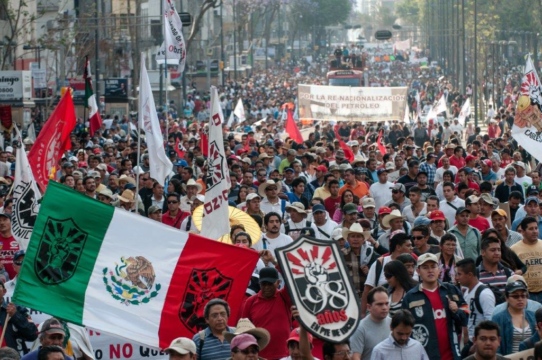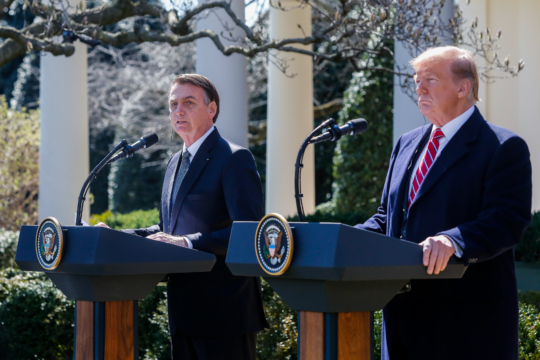
Latin America’s energy reforms will be tested in upcoming elections
2018 will be a pivotal year for energy in Latin America, as the region’s top oil producers are set to hold presidential elections that could lead to sweeping policy changes.
Lea esta publicación en español en la revista Nexos.
On June 30, the US Supreme Court issued a ruling that severely restricts the federal government’s ability to fight climate change via regulation. In West Virginia v. EPA, the court determined that the Environmental Protection Agency (EPA) does not have the authority to broadly regulate coal- and gas-fired power plants, a tool that former President Barack Obama and current President Joe Biden have intended to use to transform generation in the electricity sector. While regulating power plants was not the only tool to reach the US goal of curbing greenhouse gas (GHG) emissions 50 percent by 2030, the ruling does make these goals more reliant on legislation, which is currently gridlocked by partisan divisions. Outside the United States, the consequences for the Americas could be far-reaching in at least two dimensions: impacting regional commitments and the credibility of US diplomatic efforts to reduce emissions, and increasing vulnerability to the impacts of climate change.
Given that the United States is the second-largest global emitter, trailing only China, the ruling not only jeopardizes US pledges to reduce national emissions, but also limits global emissions-reduction potential and the ability to collectively reach the goal of holding global warming to or below 1.5 degrees Celsius. The ruling makes a major emitters’ race to the top more unlikely; in other words, if China, India, and Russia deem the United States’ pushes for ending dependency on coal as empty demands given the president’s diminished ability to achieve domestic goals via executive authority, they may lessen their own efforts. Indeed, China’s Foreign Ministry spokesperson Zhao Lijian declared the day after the ruling that tackling climate change required more than “chanting slogans,” referring to US climate action.
The ruling will likely deteriorate President Biden’s climate leadership credibility in the Americas as well, resulting in a negative domino effect in the region. For instance, Biden has been pushing Brazil to act firmly against deforestation of the Amazon, and in fact, at last year’s United Nations Climate Change Conference in Glasgow (COP26), President Jair Bolsonaro’s administration brought its target year for ending illegal deforestation forward to 2028 (from 2030). In a 2021 letter addressed to the United States, President Bolsonaro estimated that Brazil would need $1 billion dollars a year for this purpose. Although an agreement never matecrialized, and many considered Bolsonaro’s pledges to be a public relations operation, the Supreme Court’s blow could have implications for bilateral relations, particularly at the forthcoming COP27 in Egypt. The Brazilian government may take this domestic setback as an opportunity to backslide in its own efforts to combat illegal deforestation and enact sustainable agriculture measures. Moreover, Biden could lose legitimacy vis-à-vis Amazon governors, Brazilian and international environmental NGOs, and political opponents who counted on his pressure to protect the Amazon.
The ruling could also represent a setback in Mexico after pressure from US Special Presidential Envoy for Climate John Kerry seemed to soften President Andrés Manuel López Obrador’s stance regarding renewable energy, at least discursively. Amid frictions with US companies and repeated visits from Kerry, in June, López Obrador modified his usually disdainful narrative toward clean energies and private capital, a tepid yet meaningful step that the ruling could reverse. Brazil and Mexico are just two examples of the domino effect. While they together account for more than half of LAC emissions, they still emit far less carbon than the United States, where the impetus for hemispheric climate action falls on an administration that now has fewer tools to take action.
On top of weakening international climate commitments, the Supreme Court’s decision also threatens to increase the climate impacts of extreme weather events in vulnerable countries, making these events more intense and frequent. Central America, where the Biden administration’s Root Causes Strategy acknowledges the role of climate change in exacerbating other drivers of migration, will be among the most impacted regions in terms of droughts, floods, landslides, tropical storms, and hurricanes. In the Caribbean, the impacts of climate change for Small Island Developing States like Haiti (also a Least Developed Country) are potentially catastrophic given their exposure to sea-level rise and extreme weather events as well as their economic dependence on tourism. Climate change has a multiplier effect on other phenomena that plague Central America, the Caribbean, and other parts of the Americas, such as poverty, inequality, corruption, and the health crisis caused by Covid-19. Paired with these systemic issues, the effects of global warming will likely induce more migration flows and suffering for frontline populations.
While climate impacts in Latin America are increasingly visible, the United States is not immune to the impacts of climate change either. Numerous studies suggest that climate change deepens domestic racial and socioeconomic inequalities. Latino or Hispanic, Asian, and Black communities suffer outsize air pollution and climate change impacts compared to their white counterparts. Nearly 10 million Hispanics live in counties with elevated levels of air pollution, and according to a 2021 Pew Research survey, seven in ten Hispanic adults argue that climate change is affecting their local communities compared to five in ten non-Hispanic adults. Natural hazards, made longer and more frequent by climate change, also deepen the racial wealth gap.
Notwithstanding these devastating consequences, President Biden still has some tools to deliver on his promises and restore inter-American relations. While his spending bill plan has been gridlocked in Congress since December of 2021, still pending are tax credits for wind and solar energy, and for electric vehicles, which, if approved, could also ameliorate damage to his international standing and lack of delivery. Furthermore, the EPA did not lose all regulatory authority; it still has attributions to regulate coal plants and is working on rules to cut methane emissions and promote the electrification of transport.
In the regional arena, the United States can exert leadership in different ways, through continued mitigation assistance to lower-middle-income countries via the US Agency for International Development (USAID), contributions to the World Bank’s Clean Technology Fund, and support to other US government programs to protect critical carbon sinks in the Amazon. In terms of ameliorating the damage that climate change may impose on vulnerable populations in the Americas, the US presidency has powerful plans like the recently announced Partnership to Address the Climate Crisis 2030 that will advance energy security and climate resiliency in the Caribbean Community. Furthermore, President Biden has called for US$1.6 billion next fiscal year to aid developing nations through the Green Climate Fund, which his predecessor blatantly neglected.
There are other reasons to remain optimistic. A combination of factors including market pressures, state regulations, corporate energy and emissions targets, and civil society demands are still promoting decarbonization in the power sector. Indeed, the Supreme Court’s opinion does not reflect that of most Americans and is part of a series of decisions that a small group of individuals is promoting to advance a conservative agenda, which raises the questions of how democratic and representative major decisions like this are and of whose voices are being muted. According to Yale 2021 Climate Opinion Maps, 66 percent of Americans believe that there should be strict carbon emission limits on coal-fired plants, and 72 percent agree that carbon emissions should be regulated as a pollutant. The Pew Research Center reports that 69 percent of adults favor the United States becoming carbon neutral by 2050. To this end, the importance of climate democracy and justice is more important than ever.
Although the court’s decision cited the responsibility of Congress to define the EPA’s abilities through legislation, Congress remains paralyzed and stands out as an imperfect representative of majority opinion on this issue and others. Still, West Virginia v. EPA has further entrenched the fact that for the United States to truly lead on climate change, congressional action will be necessary. Barring that, the Biden administration must do what it can in the meantime to mitigate worsening climate impacts to its south and think creatively about how, in a credibility crisis, its climate diplomacy efforts in Latin America and the Caribbean can continue.
Climate Threats in the Northern Triangle: How the United States Can Support Community Resilience
Here’s How Mexico Can Clean Up Its Dirty Energy Industry
Energy and Mining in the Amazon: Corporate and Financing Landscape
2018 will be a pivotal year for energy in Latin America, as the region’s top oil producers are set to hold presidential elections that could lead to sweeping policy changes.
López Obrador’s presidency will be judged by his ability to tackle the myriad problems that beset his country while showing that change is possible within the rule of law and democratic institutions.
It is hard to imagine exactly what kind of deal Bolsonaro and Trump, both anomalous, unconventional leaders, drawn to one another mainly by temperament and ideology, could strike with another. Could they really end up accomplishing what previous governments in both countries had failed to achieve? Could they forge an alliance between two countries that have long maintained a rather distant and often distrustful relationship?

